Society adored them, but the U.S. government thought they were dangerous: black radical leaders Paul Robeson, Alice Childress, and Lorraine Hansberry transformed the cultural sphere in the U.S and beyond. They were playwrights, singers, and performers, but they were also rabble-rousers, dissidents, and even enemies of the state.
Paul Robeson was a giant, both in the struggle for civil rights, but more importantly as an actor, playwright and singer. He shared the world peace prize with Picasso and Pablo Neruda. He could count among his friends Kwame Nkrumah, the first president of Ghana, and Nehru, the first Prime Minister of India. The famed anarchist Emma Goldman, no friend to statesmen, also considered him a dear friend.
Weekly Newsletter
Alice Childress received the Tony award for the role she played in the 1944 Broadway classic Anna Lucasia. With Gold in the Tress (1952), she would become the first black woman to professionally produce a play in the United States, and, years later, the only African American woman to have been a playwright for four decades. (She wasn’t the first black woman to produce on Broadway, however. That mantle belonged to Lorraine Hansberry, with A Raisin in the Sun, who was also the first black female dramatist to win the New York Drama Critics Circle award.)
In the 1950s, the general public learned about these figures by flicking through art magazines and the New York Times, reading reviews about the groundbreaking advancements they made for the black arts. The more politically inclined might find articles written in Robeson’s Freedom newspaper, where Childress would write a fictional column on the travails of the black domestic worker, and Hansberry would report from Kenya, Korea, and Brazil, on the struggles of women to emancipate their people.
From the perspective of the FBI, however, their names were known for another reason: an infamous watchlist, which set its sights on perceived “traitors” to the nation. Because of their association with black theatre projects like the Committee for the Negro of the Arts, or, for Robeson and Hansberry, because they were open about being Marxists, the U.S. government led a concerted effort to banish them from the public eye. After the House Un-American Activities Committee began targeting artists, Childress too appeared on the FBI’s watchlist for her activism and her open association with communists.
From one perspective, perhaps this kind of targeting was inevitable for black artists, especially those who were politically active. As a columnist for the Baltimore African American put it at the time:
You can kiss the feet of Stalin, have a sickle and hammer engraved on your teeth… and you will only be a “suspected Communist.” But if you dared reveal that you hate Jim Crow… you immediately become a Damn Red.”
When the names of Robeson, Hansberry, and Childress appeared on the FBI list of suspected communists, they were accompanied by the name of Harry Belafonte, the man who would become one of Martin Luther King, Jr.’s most trusted confidants. During the era of McCarthyism, to be black was to be red.
But from another angle, these public figures’ Marxist sympathies were shared by a huge proportion of the Afro-American intelligentsia. Claude McKay and Langston Hughes, to provide two examples, are often attributed, alongside Alain Locke, as being the architects of the Harlem Renaissance. They both openly praised the Soviet Union. Indeed, both spent extensive amounts of time there.
As a student, Hansberry was a member of the Communist Party of the USA, and she went to work for Robeson’s newspaper immediately after graduating. Childress’s apartment became a hub for Herbert Aptheker and other underground Marxist academics. It was no secret that, like many in the arts at the time, they were socialists.
From the 1920s onwards, the black arts were intertwined with the cultural institutions of the U.S. radical left. Where would Childress and Hansberry be without the footway that was paved by black women before them? These included women like Louise Thompson, who found theatrical opportunity in a land that was opportunistically trying to position itself as the protector of African Americans and the colonized: the USSR. After returning from sold out shows and holiday resort to a country of segregation and Jim Crow, they became committed to fighting for a new social order.
Thompson, a key writer of the Harlem renaissance, is most famous for her thesis that black women were “triply oppressed,” as blacks, women, and workers (a precursor to the modern notion of intersectionality). It was Thompson who let Langston Hughes know, via telegram, that the USSR planned to shoot a new film called “Black and White.” She led a group of more than twenty African Americans on a trip to the USSR, where travel expenses were reimbursed by the Soviets and luxury hotels awaited them. (The film project fell apart, but members of the cast became the first black American women to perform on the Russian stage.)
It’s almost certain that Robeson, Childress, and Hansberry would have been just as talented with or without their socialist worldview. What is less certain is whether or not black theatre would have flourished in the early twentieth century in the absence of the social and cultural institutions of the U.S. radical left. For indeed it is the case that few Americans would have provided them with the stage, save for the detested communists of the era.







